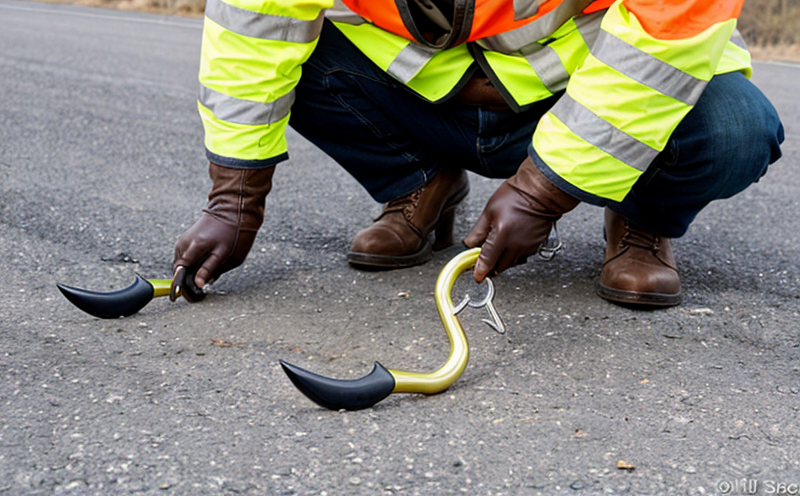Hook inspection
The inspection of hooks is a critical component in ensuring the safety and reliability of lifting equipment and cranes. Hooks are essential components in many industries, including construction, manufacturing, logistics, and transportation. They are used to securely attach loads during lifting operations, making them pivotal for preventing accidents and damage.
Hook failure can lead to catastrophic consequences, including injuries to personnel, damage to the crane itself, or even loss of life. Therefore, it is imperative that hooks undergo thorough inspection to ensure they meet safety standards and operational requirements. This service involves a detailed examination of the hook's structural integrity, wear patterns, and any other relevant factors that could affect its performance.
The inspection process typically includes visual inspections for cracks, corrosion, and deformation; non-destructive testing (NDT) methods such as magnetic particle inspection (MPI), ultrasonic testing (UT), or radiography; and sometimes destructive testing to determine the material properties. The specific methods used depend on the type of hook and its application.
For instance, forged hooks often undergo MPI to detect surface flaws, while cast hooks may require UT to assess internal defects. Destructive tests are conducted in cases where detailed metallurgical analysis is required. Acceptance criteria for these inspections are based on international standards such as ISO 4483:2015 and ASME Section VIII Division 1.
The service also includes the use of advanced technology to enhance inspection accuracy, including laser scanning and computer-aided design (CAD) software for detailed analysis. These tools help in identifying subtle defects that might be overlooked during visual inspections alone.
Once the inspection is complete, a comprehensive report detailing the findings and recommendations for any necessary repairs or replacements is provided. This report serves as a critical document for compliance with regulatory requirements and ensures that safety standards are met.
Why Choose This Test
Selecting this hook inspection service can significantly enhance operational safety and reduce the risk of accidents. By adhering to stringent testing protocols, our team ensures that every hook is in top condition before it is put into use. This proactive approach not only protects personnel but also extends the lifespan of the equipment by preventing premature failure.
The reliability of this service is underpinned by adherence to international standards and best practices. We employ highly skilled technicians with extensive experience in the field, ensuring that each inspection is conducted with precision and care. Our clients benefit from peace of mind knowing that their safety-critical components are regularly checked and maintained at peak performance levels.
In addition to enhancing safety, choosing this service can lead to significant cost savings over time. By identifying issues early through routine inspections, costly repairs or replacements can be avoided, ultimately leading to a more efficient operation. Compliance with regulatory requirements is also simplified as the inspection reports serve as clear documentation of adherence to standards.
Our clients also benefit from our commitment to continuous improvement and innovation in testing methodologies. We stay abreast of the latest industry trends and incorporate new technologies into our services, ensuring that we provide the most effective and up-to-date solutions for hook inspections.
Quality and Reliability Assurance
Visual Inspection: This involves a thorough examination of the hook to identify any visible signs of damage or wear. It is the first step in assessing the overall condition of the hook.
Magnetic Particle Inspection (MPI): MPI is used to detect surface cracks and discontinuities in ferromagnetic materials, such as steel hooks.
Ultrasonic Testing (UT): UT is employed for internal flaw detection in various materials. It can assess the thickness of the hook wall and identify any internal defects.
Radiography: This method uses X-rays or gamma radiation to create images of the interior structure of the hook, revealing hidden flaws that may not be visible on the surface.
Each inspection method has its own advantages and is chosen based on the specific requirements of the hook being inspected. For instance, MPI is particularly effective for detecting surface flaws in steel hooks, while UT can provide detailed information about internal structural integrity.
The use of these advanced techniques ensures that even the smallest defects are identified, allowing for timely intervention to prevent potential failures. The combination of visual inspection and NDT methods provides a comprehensive approach to ensuring the reliability and safety of the hook.
Competitive Advantage and Market Impact
In today's competitive market, businesses operating lifting equipment and cranes must prioritize safety and efficiency. By choosing our hook inspection service, companies can gain several key advantages:
Enhanced Safety: Our rigorous inspection process ensures that only safe hooks are put into use, reducing the risk of accidents and injuries.
Cost Efficiency: Early detection of issues through routine inspections prevents costly repairs or replacements down the line. This proactive approach also helps in optimizing operational costs by extending the lifespan of equipment.
Regulatory Compliance: The detailed inspection reports serve as robust documentation that meets all relevant regulatory requirements, streamlining compliance processes and avoiding potential legal issues.
Reputation Enhancement: Companies that prioritize safety and quality are seen as reliable partners by their clients and stakeholders. This can lead to increased business opportunities and a strong market presence.
Innovation Leadership: By staying at the forefront of testing methodologies, we offer our clients access to cutting-edge technologies and practices, setting them apart from competitors.
The impact of this service extends beyond individual companies; it contributes to the overall safety and reliability of the industry. By promoting best practices in hook inspection, we help to establish a benchmark for quality and excellence that benefits all participants in the sector.





